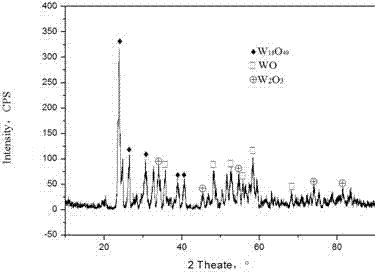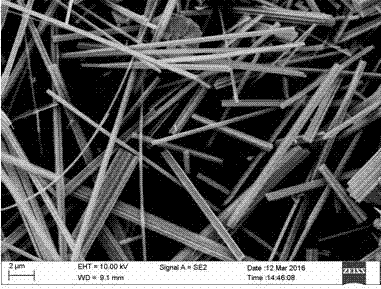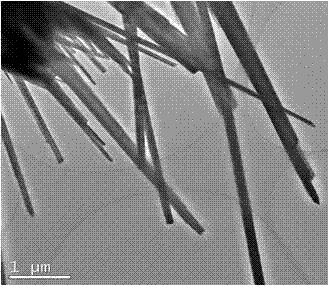Hollow-structure nano tungsten oxide wire prepared through in-situ growth of graphene oxide
A nano-tungsten oxide, in-situ growth technology, applied in the field of nano-materials, can solve the problems of high conditions and high energy consumption, and achieve the effects of high purity, simple process and large production volume
- Summary
- Abstract
- Description
- Claims
- Application Information
AI Technical Summary
Problems solved by technology
Method used
Image
Examples
Embodiment 1
[0023] The invention provides a graphene oxide in-situ growth method for preparing hollow nano-tungsten oxide wires, which is characterized in that it is formed by mixing a certain amount of graphene oxide, a precursor compound containing tungsten, absolute ethanol, and deionized water.
[0024] In the above, the tungsten-containing precursor compound is a mixture of ammonium metatungstate and tungsten carbonyl, and the mass percentage of tungsten carbonyl in the mixture to ammonium metatungstate is 1-5%; so that graphene oxide and The tungsten precursor compounds have different molar ratios. ; Graphene oxide is graphene oxide prepared by a redox method, and the mass ratio of tungsten-containing precursor compound to graphene oxide is 1:1-6; graphene oxide is wetted with a certain amount of absolute ethanol, The mass percentage of graphene oxide is 0.1~0.5%; dispersed in a certain amount of deionized water, the mass percentage of deionized water in the wetting solution is 5~8%...
Embodiment 2
[0031] A certain amount of graphite powder was added to a solution consisting of concentrated H2SO4 (12mL), K2S2O8 (2.5g) and P2O5 (2.5g), and reacted at 80°C for 4.5 hours. After cooling to room temperature, 0.5 L of deionized water was added. and dry at room temperature. Add this pre-oxidized graphite powder to 150mL of concentrated H2SO4, keep the environment at 0°C with an ice-water bath, gradually add 15g KMnO4, and keep the temperature not exceeding 20°C, and stir at 35°C for 2 hours after the addition. Then 250 mL of deionized water was added and stirred for 2 hours. Then add 0.7 L of deionized water, then add 30 mL of 30% H2O2, dry at room temperature, and then dialyze in a dialysis bag for 1 week to remove heteroions. Finally, it was vacuum filtered and dried at room temperature to obtain graphene oxide.
[0032] Weigh 2g of graphene oxide, add 1000g of absolute ethanol, stir and mix evenly, add 60g of deionized water to mix, in the ultrasonic disperser, select 10m...
Embodiment 3
[0034]A certain amount of graphite powder was added to a solution consisting of concentrated H2SO4 (12mL), K2S2O8 (2.5g) and P2O5 (2.5g), and reacted at 80°C for 4.5 hours. After cooling to room temperature, 0.5 L of deionized water was added. and dry at room temperature. Add this pre-oxidized graphite powder to 150mL of concentrated H2SO4, keep the environment at 0°C with an ice-water bath, gradually add 15g KMnO4, and keep the temperature not exceeding 20°C, and stir at 35°C for 2 hours after the addition. Then 250 mL of deionized water was added and stirred for 2 hours. Then add 0.7 L of deionized water, then add 30 mL of 30% H2O2, dry at room temperature, and then dialyze in a dialysis bag for 1 week to remove heteroions. Finally, it was vacuum filtered and dried at room temperature to obtain graphene oxide.
[0035] Weigh 3g of graphene oxide, add 1000g of absolute ethanol, stir and mix evenly, add 700g of deionized water for mixing, in the ultrasonic disperser, select...
PUM
 Login to View More
Login to View More Abstract
Description
Claims
Application Information
 Login to View More
Login to View More - R&D
- Intellectual Property
- Life Sciences
- Materials
- Tech Scout
- Unparalleled Data Quality
- Higher Quality Content
- 60% Fewer Hallucinations
Browse by: Latest US Patents, China's latest patents, Technical Efficacy Thesaurus, Application Domain, Technology Topic, Popular Technical Reports.
© 2025 PatSnap. All rights reserved.Legal|Privacy policy|Modern Slavery Act Transparency Statement|Sitemap|About US| Contact US: help@patsnap.com



